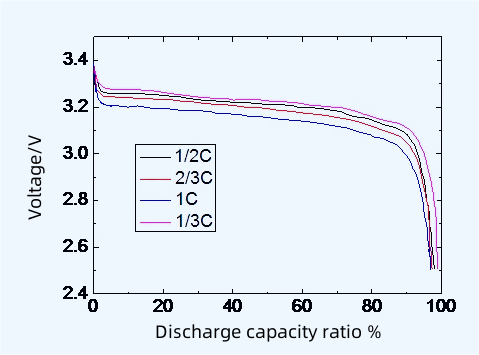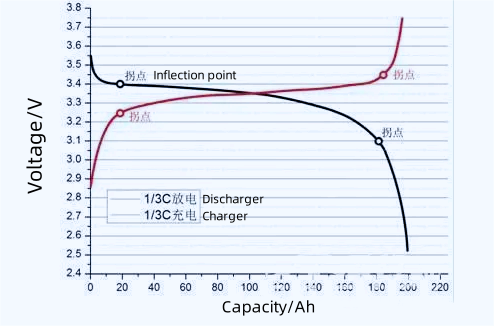Lithium battery charging and discharging curve analysis and application
Original: Lithium Battery Technology Lithium Battery Technology Knowledge Platform
Abstract: This article introduces in detail the analysis method of lithium battery charge and discharge curves, including charging efficiency, discharge characteristics, capacity evaluation, internal resistance evaluation and cycle life evaluation. By interpreting the charge and discharge curves, we can gain an in-depth understanding of the performance and characteristics of lithium batteries, providing an important basis for battery selection, use and optimization.
1. Introduction
The performance of lithium batteries is crucial to the operation of various electronic devices and power tools. The charge and discharge curve is one of the important means to evaluate the performance of lithium batteries. It can intuitively reflect the voltage and current changes of the battery during the charging and discharging process. By analyzing the charge and discharge curves, information on key parameters such as battery capacity, internal resistance, and efficiency can be obtained, thereby providing guidance for optimizing battery design and improving battery performance.
2. Lithium battery charging curve analysis
The charge and discharge curve of a lithium battery is the relationship between the voltage and the discharge capacity of the battery, and is also the curve of the remaining capacity SOC. During the charging process of the lithium battery, the voltage gradually increases and the current gradually decreases. The slope of the charging curve reflects the charging speed. The greater the slope, the faster the charging speed. At the same time, the plateau area of the charging curve indicates that the battery is fully charged, and the voltage tends to be stable at this time.
(1). Charging efficiency analysis: Charging efficiency is an important indicator to measure battery charging performance. Higher charging efficiency means that the battery can more effectively convert the input electrical energy into chemical energy and store it. By comparing the actual charging capacity and the theoretical charging capacity of the charging curve, the charging efficiency can be evaluated. In addition, the energy loss during charging can also be observed to find ways to improve charging efficiency.
(2). Charge end voltage: Charge end voltage refers to the voltage value when the battery is fully charged. Correctly setting the charge termination voltage can avoid overcharging and extend battery life. By analyzing the charging curve, the appropriate charging termination voltage is determined to ensure that the battery is charged within a safe range.
3. Lithium battery discharge curve analysis
During the discharge process, the voltage gradually decreases and the current also decreases. The shape and slope of the discharge curve can also provide important information about battery performance.
(1). Discharge characteristic evaluation: The slope of the discharge curve can reflect the discharge performance of the battery. A flatter discharge curve usually indicates that the battery has better discharge stability and can provide stable energy output. In addition, by observing the plateau area of the discharge curve, we can understand the voltage changes of the battery at different depths of discharge and evaluate the discharge capability of the battery.

(2). Discharge capacity evaluation: The area of the discharge curve is proportional to the discharge time, so the discharge capacity of the battery can be evaluated by calculating the area under the curve. The size of the discharge capacity directly affects the battery's usage time and endurance.

(3). Influence of internal resistance: Internal resistance is the resistance inside the battery, which will affect the discharge characteristics. Higher internal resistance will cause the voltage to drop faster and the discharge power to drop. By analyzing the discharge curve, the internal resistance of the battery can be estimated and its impact on battery performance can be evaluated.
4. Capacity Assessment
The capacity of a lithium battery refers to the amount of charge the battery can store, usually expressed in milliampere hours (mAh) or ampere hours (Ah). By integrating the charge and discharge curves, the actual capacity of the battery can be calculated. At the same time, multiple charge and discharge cycle tests can also be performed to observe the attenuation of capacity to evaluate the cycle life of the battery.

5. Internal resistance assessment
Internal resistance is the resistance inside the battery, which affects the battery's charge and discharge performance and efficiency. Smaller internal resistance helps improve the battery's discharge efficiency and power output. By analyzing the relationship between voltage and current changes in the charge and discharge curve, the internal resistance of the battery can be estimated. In addition, the size of the internal resistance is also related to the health status of the battery, so the internal resistance evaluation can also be used for battery fault diagnosis.

6. Cycle life assessment
Cycle life refers to the ability of a battery to maintain certain performance after multiple charge and discharge cycles. By observing the changes in the charge-discharge curve over multiple cycles, the cycle life of the battery can be evaluated. If the shape and characteristics of the curve remain relatively stable after multiple cycles, the battery has good cycle life. At the same time, the capacity attenuation during the cycle can also be analyzed to predict the service life of the battery.

7. Summary
The lithium battery charge and discharge curve is the relationship between battery voltage and discharge capacity, and is also the curve of remaining capacity SOC. It is an important means to better analyze and evaluate battery performance. Through the analysis of charging efficiency, discharge characteristics, capacity, internal resistance and cycle life, we can comprehensively understand the performance of the battery. This analysis method is of great significance for battery design optimization, quality control and application selection. In practical applications, combining a variety of testing methods and data analysis methods can more accurately evaluate the performance of lithium batteries, providing guarantee for the reliable operation of various electronic equipment and power tools.